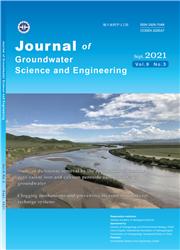鲜水河地区地热异常:对川藏铁路隧道建设的启示
IF 1.8
4区 地球科学
Q3 WATER RESOURCES
引用次数: 1
摘要
利用温度测井、温度监测和导热系数测量,结合区域地热地质调查资料,对川藏铁路沿线鲜水河地热区地热特征进行了综合分析。重点研究了地温背景、地温场及其对隧道周边的潜在影响。研究表明,研究区平均热流值约为73.0 mW/m2,显著高于中国大陆平均地面热流值(62.5 mW/m2)。这种高陆地热流表明该地区有明显的热背景。此外,发现该区地热异常与北西向断裂的温泉分布密切相关,受鲜水河断裂带的强烈控制。研究认为,高大地热流背景与导水断裂的结合是该区地热资源的有利条件。然而,这些条件也对川藏铁路沿线的隧道构成了潜在的热损伤威胁。为了评估风险,研究考虑了地面热流、隧道围岩导热系数、区域恒温层特征以及温泉和断层的分布。重点分析了通过研究区的康定1#和2#隧道的热损伤风险。根据分析结果,康定1#和2#隧道避开了大部分高温异常区域,热损风险相对较低。然而,隧道的一些部分确实穿过中低温区域,那里的表面岩石温度可高达45°C。因此,在隧道项目的建设和运营期间不应忽视这些地区,可能需要采取缓解措施来解决该地区潜在的与热有关的挑战。本文章由计算机程序翻译,如有差异,请以英文原文为准。
Geothermal anomalies in the Xianshuihe area: Implications for tunnel construction along the Sichuan-Tibet Railway, China
This study presents a comprehensively analysis of geothermal characteristics in the Xianshuihe geothermal area along the Sichuan-Tibet Railway, using temperature logging, temperature monitoring and thermal conductivity measurement, and regional geothermal geological survey data. The research focuses on the geothermal background, geothermal field, and their potential impact on the surrounding tunnels. The investigation reveals that the average heat flow value in the study area is approximately 73.0 mW/m2, significantly higher than the average terrestrial heat flow in mainland China (62.5 mW/m2). This high terrestrial heat flow signifies a distinct thermal background in the area. In addition, geothermal anomalies in the area are found to be closely associated with the distribution of hot springs along NW faults, indicating a strong control by the Xianshuihe fault zone. The study concludes that the region's favorable conditions for geothermal resources are attributed to the combination of high terrestrial heatflow background and water-conducting faults. However, these conditions also pose a potential threat of heat damage to the tunnels along the Sichuan-Tibet Railway. To evaluate the risk, the research takes into account the terrestrial heat flow, thermal conductivity of the tunnel surrounding rocks, characteristics of the regional constant temperature layer, as well as the distribution of hot springs and faults. The analysis specifically focuses on the thermal damage risk of Kangding 1# tunnel and 2# tunnel passing through the study area. Based on the findings, it is determined that Kangding 1# tunnel and 2# tunnel have relatively low risk of heat damage, as they have avoided most of the high temperature anomaly areas. However, several sections of the tunnels do traverse zones with low to medium temperatures, where surface rock temperatures can reach up to 45°C. Therefore, these regions should not be neglected during the construction and operation of the tunnel project, and mitigation measures may be necessary to address the potential heat-related challenges in the area.
求助全文
通过发布文献求助,成功后即可免费获取论文全文。
去求助
来源期刊

Journal of Groundwater Science and Engineering
WATER RESOURCES-
CiteScore
2.80
自引率
9.10%
发文量
308
期刊介绍:
It publishes original, innovative, and integrative research in groundwater science and engineering with a focus on hydrogeology, environmental geology, groundwater resources, agriculture and groundwater, groundwater resources and ecology, groundwater and geologic environment, groundwater circulation, groundwater pollution, groundwater exploitation and utilization, hydrogeological standards and methods, groundwater information science, climate change and groundwater. The Editorial Board is composed of more than sixty world-renowned experts and scholars, 47% of whom are foreign scientists. Up to now, the foreign authors contributed papers are from USA, Japan, Canada, Australia, Russia, Mongolia, Thailand and Vietnam.
 求助内容:
求助内容: 应助结果提醒方式:
应助结果提醒方式:


